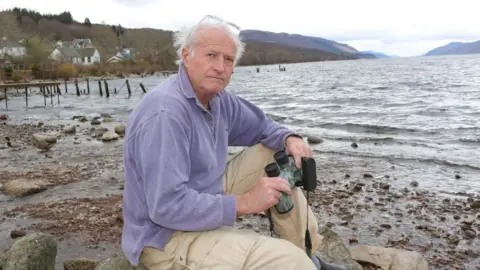Loch Ness Monster hunter: I thought this job would be easier
 Peter Jolly/Northpix
Peter Jolly/NorthpixSteve Feltham has dedicated his life to solving the mystery of the Loch Ness Monster.
He gave up his job and sold his home in Dorset to move to Dores on the shores of the loch in 1991.
Now, after more than 30 years of searching for Nessie, he said he thought the task would have been easier.
Mr Feltham made his first sighting of something unexplained within his first year of his search, and had hoped to make further sightings soon after.
He told BBC Radio's Good Morning Scotland programme: "I had one glimpse of something like a torpedo going through the water.
"I did think this job was going to easier as I had a sighting in the first year and I thought it wouldn't be long until a second sighting would come along."
Mr Feltham added: "And that is where I'm stopped, at that moment, still waiting for that second glimpse of something unexplained.
"Because I am here full-time I speak to hundreds of people who do report something that we can't identify."
Mr Feltham's dedication to his search saw him named Ambassador of the Year at the 2016 Highlands and Islands Tourism Awards.
He had previously been recognised by the Guinness Book of World Record for the longest continuous vigil hunting for the Loch Ness Monster.
The Nessie hunter's continuing efforts come 90 years after what is described as the first modern sighting of a monster.

In April 1933, hotel manageress Aldie Mackay told of seeing a whale-like creature and the loch's water "cascading and churning".
The Inverness Courier newspaper reported the sighting and the editor at the time, Evan Barron, suggested the beast be described as a "monster" - kick-starting the modern myth of Nessie.
In an interview years later, Mrs Mackay said she had seen something "black, wet, with the water rolling off it" moving in a circle. She described it as a "beast" to her husband.
The legend dates back to the Middle Ages when Irish monk St Columba is said to have encountered a creature in the Ness, a river that flows from Loch Ness.
 Getty Images
Getty ImagesBut in 2019, scientists reported the creatures behind repeated sightings may be giant eels.
Researchers from New Zealand catalogued all living species in the loch from DNA extracted from water samples.
Following analysis, the scientists ruled out the presence of large animals said to be behind reports of a monster.
No evidence of a prehistoric marine reptile called a plesiosaur or a large fish such as a sturgeon were found.
Catfish and suggestions that a wandering Greenland shark were behind the sightings were also discounted.
